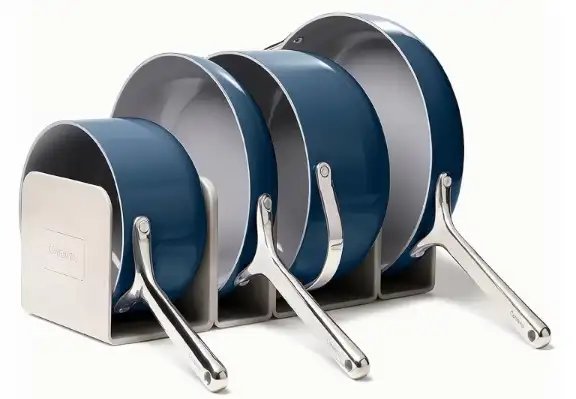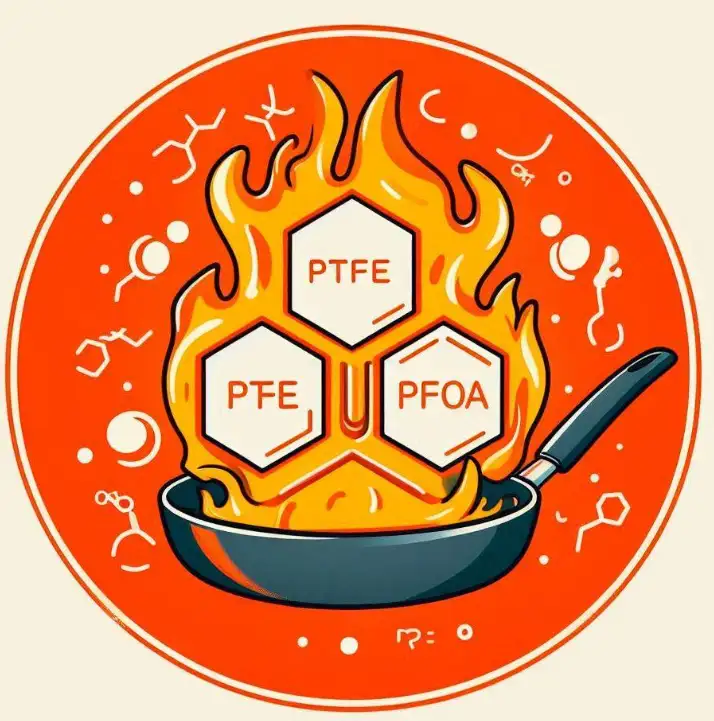When it comes to non-stick cookware, many of us have heard about PTFE and PFOA. But are they the same thing?
The short answer is no, but understanding the difference between these two substances is crucial for your health and safety in the kitchen.
Let’s break it down to clear up the confusion and help you make informed decisions when choosing non-stick cookware. Dive deeper into PTFE and Teflon differences here.
What is PTFE?
PTFE, or polytetrafluoroethylene, is a synthetic polymer known for its remarkable non-stick properties.
Most commonly recognized as Teflon (a trademark owned by Dupont), PTFE is the substance used to coat non-stick cookware like frying pans, baking sheets, and even grills.
It is a solid material that is highly resistant to heat and chemicals, making it perfect for everyday cooking.
PTFE is generally considered safe for cooking because it is inert, meaning it doesn’t react with food at typical cooking temperatures.
This makes it an ideal material for those looking for cookware that helps reduce the need for extra oils and fats.
However, there is one important consideration: PTFE can release toxic fumes when heated to extremely high temperatures, typically above 500°F (260°C).
These fumes can be harmful to both humans and pets, so it’s vital not to overheat your non-stick cookware.
To be on the safe side, always follow the manufacturer’s guidelines and avoid using PTFE-coated cookware at excessively high temperatures.
What is PFOA?
PFOA, or perfluorooctanoic acid, is a synthetic chemical compound that was historically used in the production of PTFE, including Teflon products.
Unlike PTFE, PFOA is not found in the final non-stick product, but it was involved in the manufacturing process.
This chemical raised significant environmental and health concerns due to its persistence in both the environment and the human body.
For many years, PFOA was linked to various health problems, including potential carcinogenic effects and developmental issues.
Research showed that long-term exposure to PFOA could lead to serious health concerns, prompting a major shift in the manufacturing process.
Since 2010, many manufacturers have phased out the use of PFOA in the production of PTFE, resulting in PFOA-free cookware.
This move was made to reduce environmental harm and the potential health risks associated with this chemical.
Are PTFE and PFOA the Same?
The simple answer is no—PTFE and PFOA are not the same. PTFE is the actual non-stick coating on cookware, while PFOA was once used in the production process of PTFE.
The key difference lies in their roles: PTFE is the non-stick material that makes cooking easier, while PFOA was a chemical that could pose significant environmental and health risks.
It’s important to note that while PTFE is generally considered safe when used correctly, PFOA is the chemical that has raised the most concern.
Since PFOA has been phased out of most non-stick cookware production, it is no longer a common issue for those purchasing new cookware today.
Why Should You Care About PFOA and PTFE?
As a responsible consumer, it’s crucial to understand the potential health and environmental impacts of the products you use, especially when it comes to items like non-stick cookware that are used daily in your kitchen.
- Health Concerns: PTFE is safe at normal cooking temperatures, but overheating it can release harmful fumes. PFOA, on the other hand, was linked to health issues like cancer and developmental problems, making it a substance to avoid in cookware.
- Environmental Impact: PFOA is a persistent pollutant, meaning it doesn’t break down easily in the environment. This has led to contamination in water supplies and wildlife. Thankfully, most cookware today is free from PFOA, but it’s still important to check product labels.
- Making Safe Choices: When shopping for non-stick cookware, look for products that are labeled “PFOA-free.” Many manufacturers now offer PTFE-coated cookware that is made without the use of PFOA, ensuring a safer cooking experience for you and your family.
How to Choose Safe Non-Stick Cookware
When selecting non-stick cookware, it’s important to choose products that prioritize both safety and performance.
Here are a few tips for making the best choice:
- Look for PFOA-free labels: Many manufacturers have phased out PFOA in their cookware production. Make sure to buy from reputable brands that clearly state their products are PFOA-free.
- Check the temperature guidelines: While PTFE is safe at typical cooking temperatures, remember that it can release toxic fumes if overheated. Always avoid cooking on high heat and never leave non-stick cookware unattended on a hot burner.
- Consider alternative options: If you’re still concerned about PTFE or PFOA, there are alternative non-stick coatings available, such as ceramic-based cookware, which offer a safer cooking experience.

Conclusion
In summary, PTFE and PFOA are not the same, though they are often linked in discussions about non-stick cookware.
PTFE is the non-stick coating that helps food slide off easily, while PFOA was a chemical used in the production of PTFE that has since been phased out due to health and environmental concerns.
When choosing cookware for your kitchen, prioritize products that are PFOA-free and always follow proper cooking guidelines to ensure safe and enjoyable cooking experiences.
With the right knowledge, you can make informed choices that protect both your health and the environment.
If you’re looking to upgrade your cookware, check out some of our recommended PFOA-free, high-quality non-stick cookware below.
Stay safe and happy cooking!

